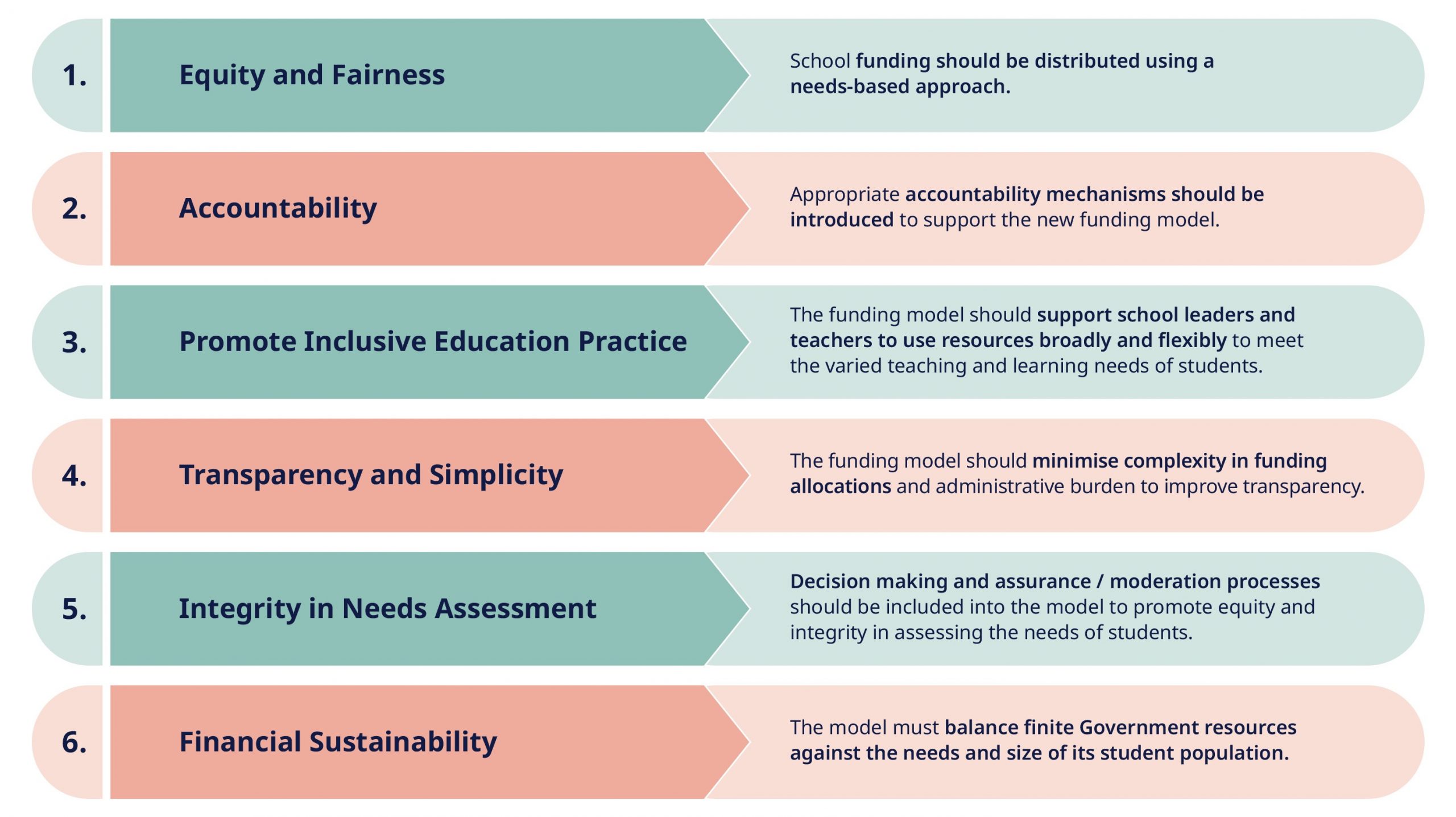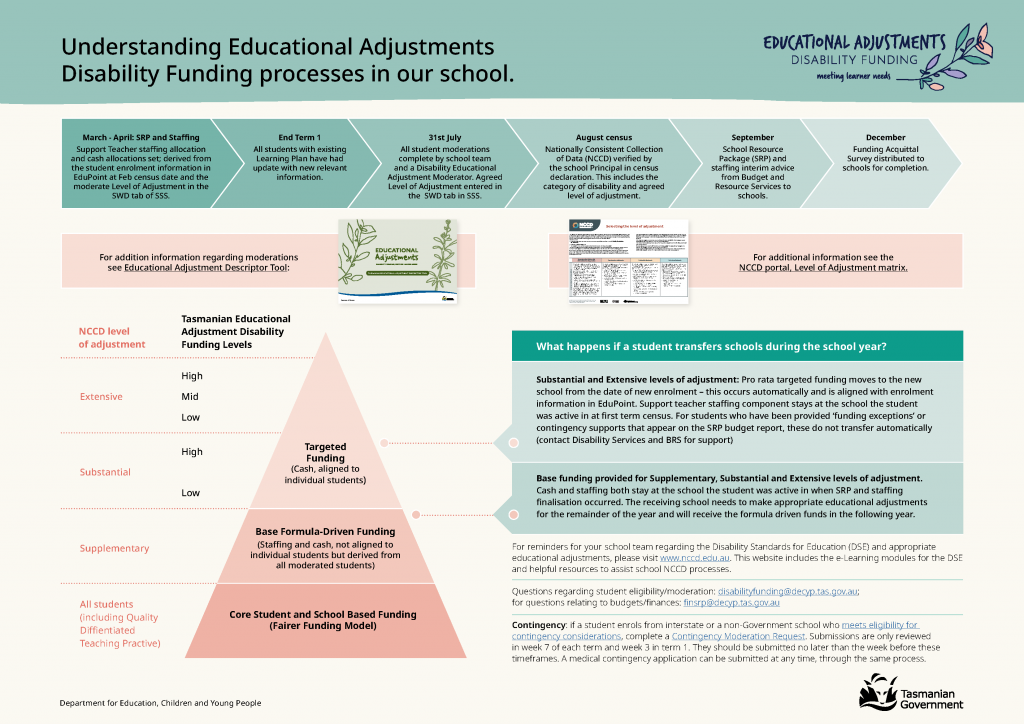Key information
- Overview of the Model and structure
- Underpinning Principles
- What to expect with moderation
Our commitment
The Department for Education, Children and Young People Tasmania supports the rights of children and young people with a disability to access education on the same basis as their peers.
Educational Adjustment Disability Funding
The Education Adjustment Disability Funding Model is based on student needs and is guided by key principles. The model delivers resources to Tasmanian Government schools to support educational adjustments that they provide for students with disability. Educational adjustments are all the things that schools do to help a student with disability. We use adjustments to make sure that everyone can access, participate and engage on the same basis as their peers.The Department for Education, Children and Young People worked with an independent consultancy company, KPMG, to develop the Educational Adjustment model. The model was developed using both research and consultation. KPMG’s final report is available at Development of a Needs-Based Funding Model for Students with Disability – Final Report (PDF, 700KB).
The Tasmanian Educational Adjustments Disability Funding Model is guided by six key ideas:

- Equity and Fairness. Schools funding should be distributed using a needs-based approach
- Accountability. Appropriate accountability mechanisms should be introduced to support the new funding model
- Promote Inclusive Education Practice. The funding model should support school leaders and teachers to use resources broadly and flexibly to meet the varied teaching and learning needs of students
- Transparency and Simplicity. The funding model should minimise complexity in funding allocations and administrative burden to improve transparency
- Integrity in Needs Assessment. Decision making and assurance / moderation processes should be included into the model to promote equity and integrity in assessing the needs of students.
- Financial sustainability. The model balance finite Government resources against the needs and size of its student population.
Structure of the Model
The Educational Adjustments Funding Model is based on a simple, structured approach to funding and resourcing. It takes into consideration the additional and changing needs of students with disability.
In the model, students who are provided with more intense support and adjustments receive more resources than those with a lower level of support and adjustments.
The model links with the Nationally Consistent Collection of Data (NCCD) levels of educational adjustment:
- Extensive
- Substantial
- Supplementary
- Quality Differentiated Teaching Practice.
The levels of adjustment for the Tasmanian model are almost the same but there are extra levels in Substantial and Extensive. This helps us to provide resources where they are needed.
Look at the diagram below for more details about the Tasmanian disability funding levels.

The Educational Adjustments Disability Funding Model allocates resources (support teacher staffing and money) to schools for each student at the Supplementary, Substantial and Extensive levels of adjustment.
At the Substantial adjustment level there are two different levels of resource allocation: Substantial High and Substantial Low.
At the Extensive adjustment level there are three different levels of resource allocation: Extensive High, Extensive Mid and Extensive Low.
Students at the level of Quality Differentiated Teaching Practice are supported through usual school processes.
Core funding is given to schools for all students. This is used to support students in the Quality Differentiated Teaching Practice level of adjustment. Core funding for each school is worked out using the Fairer Funding Model.
Moderation and Educational Adjustment Descriptor Tool
Each year a Disability Educational Adjustment Moderator works with each Tasmanian Government school to talk about all students with disability who need educational adjustments. This is called the moderation process.
During the moderation process, moderators and school staff identify the level of adjustment in place for each student, using the Educational Adjustment Descriptor Tool (PDF, 800KB), together with the other documents the school has that tell about the educational adjustments in place (e.g. the student’s Learning Plan). The tool helps us to understand each of the levels of adjustment, especially the extra levels in the Extensive and Substantial range.
Resource Allocation
To implement the Educational Adjustments Model, an increased allocation of funding was made by Government. This funding is distributed on a yearly basis to support student need. This includes more Support Teachers in schools as well as more money to pay for educational adjustments that students need.
How does it work in local schools?
- The Model gives a base allocation to every school (which includes Support Teacher staffing and money) for every student in the NCCD from Supplementary to Extensive.
- There are two parts:
- Formula Based Allocation (Support teacher allocation and money)
- This is not tagged for individual students and is provided to schools flexibly to help them support students with disability.
- The allocation is based on all students moderated at Supplementary, Substantial and Extensive levels of adjustment.
- It provides base funding for teacher-led adjustments for students
- This allocation stays at the school if the student moves.
- Formula Based Allocation (Support teacher allocation and money)
- Targeted allocation (money)
- This funding is given to schools to support students moderated at the Substantial and Extensive levels. It is used to make educational adjustments for these students.
- If the student moves to another Tasmanian government school, the money goes to the student’s new school.
How does it work in Support Schools?
- The same Educational Adjustments Model is used in DECYP Support Schools.
- In Support Schools, the model considers the number of students, the programs offered, and the general school running costs.
In Support Schools, the model delivers more base funding. This lets the support schools deliver quality educational adjustments to meet the needs of their students in their school context.
Background Information
Nationally Consistent Collection of Data (NCCD)
The Educational Adjustments Disability Funding model uses the NCCD levels of adjustment, :
- Extensive
- Substantial
- Supplementary
- Quality Differentiated Teaching Practice.
The levels of educational adjustments are decided by the individual needs of the student and show how school teams support students to access, participate and engage in school on the same basis as other students.
The NCCD data collection is based on the responsibilities of all schools under the
he model links to the DDA definition of disability. Only students who meet this definition of disability can have supports through the Educational Adjustments Disability Funding model.
More information is available at Nationally Consistent Collection of Data (NCCD).
Ministerial Taskforce
A needs based funding model was recommended by the 2014 Ministerial Taskforce Report, Improved Support for Students with Disability (PDF, 1.2MB).
The Taskforce recommended changing Tasmania’s disability education funding model to have a needs-based approach and better support inclusive practice in Tasmanian government schools.
